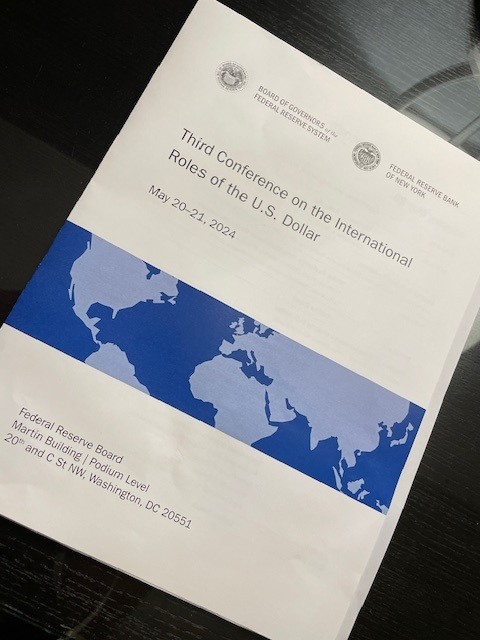It was a real pleasure to get to attend the conference (agenda here). Incredibly informative and stimulating — sometimes I think I know a lot about a subject, but conferences like this disabuse me of that notion.
I add links to ungated versions of the papers presented today, below:
Welcoming Remarks
Chair: Beth Anne Wilson (Federal Reserve Board)
Christopher J. Waller, Governor, Federal Reserve Board
Session Chair: Alain Chaboud (Federal Reserve Board)
Which Exchange Rate Matters to Global Investors?
Presenter: Kristy Jansen (University of Southern California Marshall)
Discussant: Alexandra Tabova (Federal Reserve Board)
Session Chair: Ricardo Correa (Federal Reserve Board)
The Dollar in an Era of International Retrenchment
Presenter: Ryan Chahrour (Cornell University)
Discussant: Chris Clayton (Yale University)
Presenter: Linda Goldberg (Federal Reserve Bank of New York)
Discussant: Menzie Chinn (University of Wisconsin Madison)
Moderator: Michelle Neal, Federal Reserve Bank of New York
Tobias Adrian (International Monetary Fund)
Morten Bech (Bank for International Settlements)
Joyce Chang (JP Morgan)
Wenxin Du (Columbia University)
Jay Shambaugh (U.S. Department of the Treasury)
Session Chair: Juan M. Londono (Federal Reserve Board)
Dealer Risk Limits and Currency Returns
Presenter: Hillary Stein (Federal Reserve Bank of Boston)
Discussant: Amy Wang Huber (University of Pennsylvania)
Stijn Claessens (Yale University)
Organized by Ricardo Correa, Linda Goldberg, Juan Londono, Fabiola Ravazolla.
I’d seen one paper presented before (“…International Retrenchment”), but everything else was a revelation. Jansen’s paper documented how bond holdings — both American and Euro area — responded to dollar appreciation. “Dealer risk…” presented a model of fx supply, demand and intermediaries, with endogenously determined risk limits. Bottom line is that desk limits amplify depreciations in response to demand shocks. Stijn Claessens’ keynote provided a tour d’horizon of the dollar as an international currency, thinking about how certain dimensions in the Kenen typology of money can be thought of as market mediated (store of value and medium of exchange) while others are not (unit of account). High quality discussions of th e papers all around (particularly helpful for those of us who for instance don’t know the literature in microeconomic models of dealer markets).
I had the privilege of discussing Linda Goldberg and Oliver Hannaoui’s “Dollar Share…”, which informed some of our thinking on our own work. Paper link above, unfortunately for now no slides. My comments here.
I can’t do an exhaustive review, but one can get an idea from the papers. A recap of the meeting two years ago, here. Excellent summary for the conference last year from NY Fed/Liberty Street blog.
Aside: a great side benefit of being at a conference in-person is that you get to talk to the discussants and other participants about what they’re working on. Much harder to do via zoom. Some thoughts in tomorrow’s post.

OFFICE of the UNITED STATES TRADE REPRESENTATIVE
EXECUTIVE OFFICE OF THE PRESIDENT
FOUR-YEAR REVIEW OF ACTIONS
TAKEN IN THE SECTION 301 INVESTIGATION: CHINA’S ACTS, POLICIES, AND PRACTICES RELATED TO TECHNOLOGY TRANSFER, INTELLECTUAL PROPERTY, AND INNOVATION
https://ustr.gov/sites/default/files/USTR%20Report%20Four%20Year%20Review%20of%20China%20Tech%20Transfer%20Section%20301.pdf
Kevin Drum on his blog provides a summary.
I’m gonna be busy, I see.
I think I already see how dealer risk limits could amplify fx swings. If my guess is right, it’s damned if ya do, dated if ya don’t. A big question – how much more liquidity would dealers provide absent risk limits? -is probably unanswerable before the fact. Market conditions, business conditions, losses and gains in other markets, are all factors in determining dealers willingness to provide liquidity. Limiting risk before the fact probably helps, but when shocks hit, we probably want dealers to have a lot of flexibility in trading fx.
Same with “too big to fail” and other regulatory issues. Keeping financial structures resilient to shock is a quotidian exercise. When the shock comes, government liquidity provision and risk absorption are the really useful tools; back to the regulatory “put”. Regulation to prevent morally hazardous behavior males sense in a world in which government intervenes during crisis.
Buy maybe I should read the paper, huh?